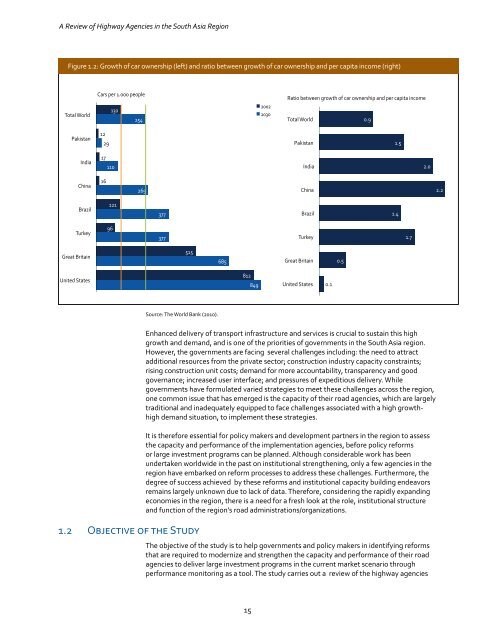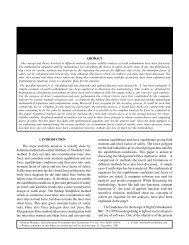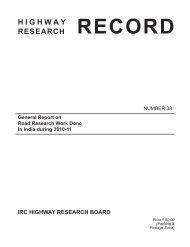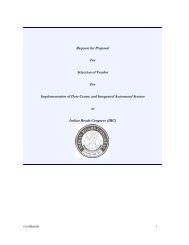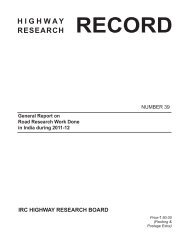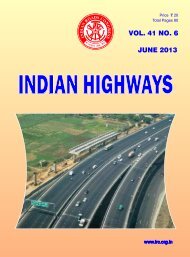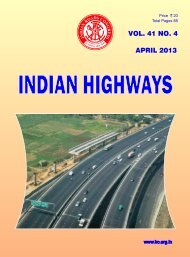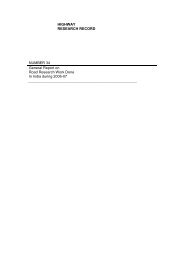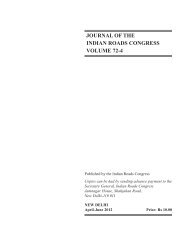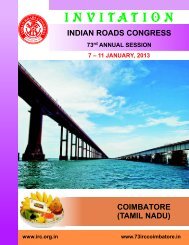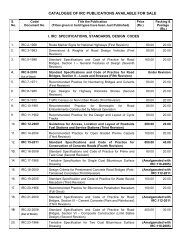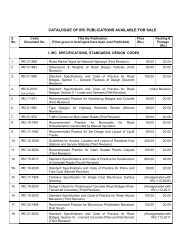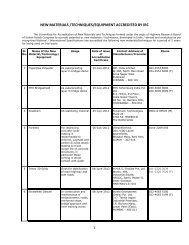A Review of Highway Agencies in the South Asia Region
A Review of Highway Agencies in the South Asia Region
A Review of Highway Agencies in the South Asia Region
You also want an ePaper? Increase the reach of your titles
YUMPU automatically turns print PDFs into web optimized ePapers that Google loves.
A <strong>Review</strong> <strong>of</strong> <strong>Highway</strong> <strong>Agencies</strong> <strong>in</strong> <strong>the</strong> <strong>South</strong> <strong>Asia</strong> <strong>Region</strong><br />
Figure 1.2: Growth <strong>of</strong> car ownership (left) and ratio between growth <strong>of</strong> car ownership and per capita <strong>in</strong>come (right)<br />
Total World<br />
Pakistan<br />
India<br />
Ch<strong>in</strong>a<br />
Brazil<br />
Turkey<br />
Great Brita<strong>in</strong><br />
United States<br />
Cars per 1.000 people<br />
12<br />
17<br />
29<br />
16<br />
110<br />
121<br />
96<br />
130<br />
254<br />
269<br />
377<br />
377<br />
515<br />
Source: The World Bank (2010).<br />
1.2 Objective <strong>of</strong> <strong>the</strong> Study<br />
685<br />
812<br />
15<br />
849<br />
2002<br />
2030<br />
Ratio between growth <strong>of</strong> car ownership and per capita <strong>in</strong>come<br />
Total World<br />
Pakistan<br />
Turkey<br />
Great Brita<strong>in</strong><br />
United States<br />
Enhanced delivery <strong>of</strong> transport <strong>in</strong>frastructure and services is crucial to susta<strong>in</strong> this high<br />
growth and demand, and is one <strong>of</strong> <strong>the</strong> priorities <strong>of</strong> governments <strong>in</strong> <strong>the</strong> <strong>South</strong> <strong>Asia</strong> region.<br />
However, <strong>the</strong> governments are fac<strong>in</strong>g several challenges <strong>in</strong>clud<strong>in</strong>g: <strong>the</strong> need to attract<br />
additional resources from <strong>the</strong> private sector; construction <strong>in</strong>dustry capacity constra<strong>in</strong>ts;<br />
ris<strong>in</strong>g construction unit costs; demand for more accountability, transparency and good<br />
governance; <strong>in</strong>creased user <strong>in</strong>terface; and pressures <strong>of</strong> expeditious delivery. While<br />
governments have formulated varied strategies to meet <strong>the</strong>se challenges across <strong>the</strong> region,<br />
one common issue that has emerged is <strong>the</strong> capacity <strong>of</strong> <strong>the</strong>ir road agencies, which are largely<br />
traditional and <strong>in</strong>adequately equipped to face challenges associated with a high growthhigh<br />
demand situation, to implement <strong>the</strong>se strategies.<br />
It is <strong>the</strong>refore essential for policy makers and development partners <strong>in</strong> <strong>the</strong> region to assess<br />
<strong>the</strong> capacity and performance <strong>of</strong> <strong>the</strong> implementation agencies, before policy reforms<br />
or large <strong>in</strong>vestment programs can be planned. Although considerable work has been<br />
undertaken worldwide <strong>in</strong> <strong>the</strong> past on <strong>in</strong>stitutional streng<strong>the</strong>n<strong>in</strong>g, only a few agencies <strong>in</strong> <strong>the</strong><br />
region have embarked on reform processes to address <strong>the</strong>se challenges. Fur<strong>the</strong>rmore, <strong>the</strong><br />
degree <strong>of</strong> success achieved by <strong>the</strong>se reforms and <strong>in</strong>stitutional capacity build<strong>in</strong>g endeavors<br />
rema<strong>in</strong>s largely unknown due to lack <strong>of</strong> data. Therefore, consider<strong>in</strong>g <strong>the</strong> rapidly expand<strong>in</strong>g<br />
economies <strong>in</strong> <strong>the</strong> region, <strong>the</strong>re is a need for a fresh look at <strong>the</strong> role, <strong>in</strong>stitutional structure<br />
and function <strong>of</strong> <strong>the</strong> region’s road adm<strong>in</strong>istrations/organizations.<br />
The objective <strong>of</strong> <strong>the</strong> study is to help governments and policy makers <strong>in</strong> identify<strong>in</strong>g reforms<br />
that are required to modernize and streng<strong>the</strong>n <strong>the</strong> capacity and performance <strong>of</strong> <strong>the</strong>ir road<br />
agencies to deliver large <strong>in</strong>vestment programs <strong>in</strong> <strong>the</strong> current market scenario through<br />
performance monitor<strong>in</strong>g as a tool. The study carries out a review <strong>of</strong> <strong>the</strong> highway agencies<br />
India<br />
Ch<strong>in</strong>a<br />
Brazil<br />
0.1<br />
0.5<br />
0.9<br />
1.5<br />
1.4<br />
1.7<br />
2.0<br />
2.2


